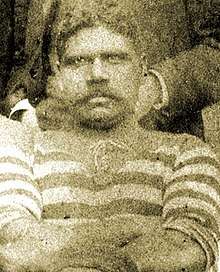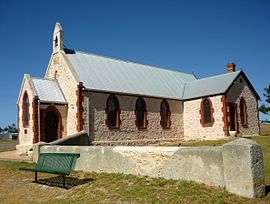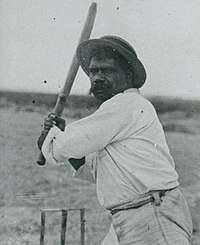Harry Hewitt
Harry Hewitt, sometimes spelled "Ewart", (c. 1861 – 23 January 1907) was an Indigenous Australian Australian rules footballer and cricketer.
| Harry Hewitt | |||
|---|---|---|---|
 Harry Hewitt in 1894 pictured wearing the Southern South Australia representative football side guernsey. | |||
| Personal information | |||
| Full name | Harry Hewitt (Hewit) | ||
| Date of birth | ≈1862[1] | ||
| Place of birth | South Australia (south-east) | ||
| Date of death | 23 January 1907 (approx. 45)[1] | ||
| Original team(s) | Point McLeay[2] | ||
| Position(s) | Back Pocket, Rover[3] | ||
| Playing career | |||
| Years | Club | Games (Goals) | |
| 1889, 1891–1892 | Medindie | 5 (0) | |
| 1891 | Port Adelaide | 1 (0) | |
| Career highlights | |||
| |||
Early life

Harry Hewitt was born in the south-east of South Australia and was taken to the Point McLeay Mission Station as a child.[4] Around this time David Uniapon would have been born at the Point McLeay Mission.[5]
Football
In 1885 Harry Hewitt captained an All-Indigenous team against a combined team of senior and junior association clubs at Adelaide Oval, that apart from a dubious umpire call regarding a rushed behind, the game resulted in a draw.[6] On the 6 July 1885, Harry Hewitt captained the Point McLeay team against a side composed Prince Alfred and Whinham College players with the college team winning by 1 goal.[7]
South Australian Football Association (1889–1892)
On the 22 June 1889 Hewitt made his senior debut for Medindie in the South Australian Football Association (SAFA) in a game against Port Adelaide at Adelaide Oval.[8] The local Port Adelaide newspaper wrote a glowing appraisal of his play stating "The Medindies had their full strength; Hewit, an aboriginal, was a decided acquisition, and although he played barefooted was about the best man amongst them, his alacrity all through the game eliciting the applause of the spectators. He, too, appeared to have a thorough knowledge of the rules of the game, as he never had a mark given against him the whole of the afternoon."[9] On the 13 July 1889 Harry Hewitt and Medindie organised to bring the Point McLeay football team to Kensington Oval to play Medindie with boomerang demonstrations during the breaks.[10]
In June 1891, the South Australia Register highlighted Hewitt's game for Medindie in a win against Adelaide at Kensington Oval insisting that "A word of praise must be given to Harry Hewitt, the aboriginal. Only once during the game, when he got hold of the ball, was he caught and spoiled. His running especially deserves recording, and he ought to prove of great benefit to the Medindies".[11] Another newspaper, the Adelaide Observer considered him a unanimous best afield for the match.[12] Later that year in August, Hewitt played for Port Adelaide against a travelling Fitzroy at Adelaide Oval.[13] Port Adelaide would defeat Fitzroy by 2 goals.[14]
In 1892 Harry Hewitt was selected in a representative side from the Southern half of South Australia to play a team representing the Northern half with players from 31 clubs across the state having players submitted.[15] Hewitt's Southern side would win the match with the South Australian Chronicle praising the play of himself and fellow Point McLeay teammate Wilson stating that "A feature of the game was the introduction of four natives from the Point Mcleay station, and as far as two of them — J. Wilson and Harry Hewitt are concerned they played the game of the forty in the first half, and subsequently did splendid service for their side. Both are strongly-built men, play a gentlemanly game, and are most unselfish. Wilson in the ruck and Hewitt roving treated the spectators to some clever football, their agility in nonplussing their opponents and exceedingly smart passing on from one to another being unsurpassed, and the spectators time after time expressed their approval of the brilliancy of their work."[16]
| Harry Hewitt's top level Australian rules football matches | ||||||
|---|---|---|---|---|---|---|
| Date | Team | Opponent | Ground | Crowd | Result | |
| 22 June 1889 | Medindie | Port Adelaide | Adelaide Oval | Loss | [17] | |
| 29 June 1889 | Medindie | Norwood | Kensington Oval | Loss | [18] | |
| 23 May 1891 | Medindie | South Adelaide | Adelaide Oval | Loss | [19] | |
| 30 May 1891 | Medindie | Adelaide | Kensington Oval | Win | [20] | |
| 1 August 1891 | Port Adelaide | Fitzroy (VFA) | Adelaide Oval | 4000 | Win | [21] |
| 2 July 1892 | Medindie | South Adelaide | Adelaide Oval | 300 | Win | [22] |
Cricket

In 1892, Hewitt had a batting average of 130 for Point McLeay in the local competition.[23]
In 1895 whilst playing for a Northern Adelaide cricket team known as the Federal eleven against a side representing Prospect, Hewitt scored 144 not out.[24]
In an 1897 edition of "Cricket Notes" in the Adelaide Evening Journal, when discussing local country cricketers in South Australia, he was described as being "The best batsman we met was the evergreen Harry Hewitt at Port Victor, whose batting, bowling, and fielding were worthy of his palmiest days".[25]
In his last season of cricket for a club representing Victor Harbor, Hewitt averaged 70 runs for the season.[1]
Advocate for the rights of Indigenous people
Hewitt wrote to and was published by the Adelaide Advertiser regarding a complaint about the treatment of Indigenous people. He was quoted as saying:
"Sir, As an aboriginal, may I say a few words about the fisherman's license? First, the white man took the land from us and killed our game, and now he expects us to pay £1 license before we can catch fish for the market. True, we can catch fish for our own use without a license, but what is the good of that? We have few opportunities for earning a livelihood, and now they are trying to stop us from earning a honest shilling. They are not getting rid of us fast enough, too they think they will starve us out. Perhaps, however, the Government have some means of keeping us in comfort, so that we won’t have to trouble about getting our living – I am." [26]
Temperance
Harry Hewitt once addressed an audience in the Adelaide City Mission praising temperance. He would do the same fortnightly at the Point Macleay Mission urging locals to the claims of temperance and would organise men to play football games in Adelaide who were members of the Blue Ribbon Army.[24]
Death
On the morning of 24 January 1907, Hewitt was found dead due an impact to the head which had crushed his skull.[24] The only witness, Jennie Tripp, said that a quantity of wine had been consumed the previous evening before Hewitt and his friend Tommy Lawson began fighting. Hewitt had struck her when she tried to intervene, and she did not see the blow that killed him, but later found a length of wood which she believed was the weapon used. Lawson, who was drunk when arrested the following morning, and at the inquest was put on remand for his murder.[27] At the trial, which was for manslaughter, the jury accepted the argument that the stick produced could not have caused the fatal injury, and if he had struck the much stronger Hewitt, it was in self-defence, so returned a verdict of "not guilty".[28]
References
| Wikimedia Commons has media related to Harry Hewitt. |
- "An Aboriginal Tragedy". Evening Journal. XLI (11210). Adelaide. 25 January 1907. p. 2. Retrieved 17 February 2017 – via National Library of Australia.
- "Football". South Australian Chronicle. XXXIV (1, 764). 11 June 1892. p. 15. Retrieved 21 July 2017 – via National Library of Australia.
- "FOOTBALL". South Australian Register. LVII (14, 234). 27 June 1892. p. 7. Retrieved 21 July 2017 – via National Library of Australia.
- "An Aboriginal Tragedy". The Observer. LXIV (3, 409). Adelaide. 2 February 1907. p. 41. Retrieved 21 July 2017 – via National Library of Australia.
- Graham Jenkin, Conquest of the Ngarrindjeri, The Story of the Lower Murray lakes Tribes,(1979)1985 Rigby reprint p.185
- "Football". The South Australian Advertiser. XXVII (8304). 30 May 1885. p. 7. Retrieved 17 February 2017 – via National Library of Australia.
- "FOOTBALL". The South Australian Advertiser. XXVIII (8338). 9 July 1885. p. 7. Retrieved 11 November 2017 – via National Library of Australia.
- "FOOTBALL". The Advertiser. XXXI (9573). Adelaide. 24 June 1889. p. 5. Retrieved 11 November 2017 – via National Library of Australia.
- "Football". Port Adelaide News and Lefevre's Peninsula Advertiser. XII (830). South Australia. 28 June 1889. p. 2. Retrieved 20 July 2017 – via National Library of Australia.
- 1889 'THE SPIRIT OF THE INSOLVENCY LAWS.', South Australian Register (Adelaide, SA : 1839–1900), 13 July, p. 5., viewed 11 Nov 2017, http://nla.gov.au/nla.news-article54594346
- "Football". South Australian Register. LVI (13, 899). 1 June 1891. p. 7. Retrieved 21 July 2017 – via National Library of Australia.
- "Football". Adelaide Observer. XLVIII (2592). 6 June 1891. p. 20. Retrieved 21 July 2017 – via National Library of Australia.
- "The Fitzroy Matches". South Australian Chronicle. XXXIV (1, 720). 8 August 1891. p. 15. Retrieved 9 April 2017 – via National Library of Australia.
- "FOOTBALL". The Express and Telegraph. XXVIII (8, 303). South Australia. 3 August 1891. p. 4. Retrieved 20 July 2017 – via National Library of Australia.
- "FOOTBALL NOTES". The Express and Telegraph. XXIX (8, 558). South Australia. 4 June 1892. p. 6. Retrieved 21 July 2017 – via National Library of Australia.
- "North v. South". South Australian Chronicle. XXXV (1, 767). 2 July 1892. p. 15. Retrieved 21 July 2017 – via National Library of Australia.
- 'FOOTBALL', The Advertiser (Adelaide), 24 June 1889, p. 5., viewed 12 Nov 2017
- 'Football.', Evening Journal (Adelaide), 1 July 1889, p. 4. (SECOND EDITION), viewed 12 Nov 2017
- 'FOOTBALL.', The Advertiser (Adelaide), 25 May 1891, p. 3., viewed 12 Nov 2017
- 'Football.', Evening Journal (Adelaide), 1 June 1891, p. 3. (SECOND EDITION), viewed 12 Nov 2017
- 'FOOTBALL.', South Australian Register (Adelaide), 3 August 1891, p. 7., viewed 12 Nov 2017
- 'FOOTBALL.', The Advertiser (Adelaide), 4 July 1892, p. 6., viewed 12 Nov 2017
- "Sporting Notes". The Areas' Express. XVII (1, 330). South Australia. 13 January 1893. p. 2. Retrieved 21 July 2017 – via National Library of Australia.
- "AN ABORIGINAL TRAGEDY". The Observer. LXIV (3, 409). Adelaide. 2 February 1907. p. 41. Retrieved 21 July 2017 – via National Library of Australia.
- "CRICKET". Evening Journal. XXIX (8256). Adelaide. 1 May 1897. p. 7. Retrieved 21 July 2017 – via National Library of Australia.
- "AN ABORIGINAL'S COMPLAINT". The Advertiser. XLVII (14, 448). Adelaide. 7 February 1905. p. 6. Retrieved 17 February 2017 – via National Library of Australia.
- "The Milang Tragedy". The Register (Adelaide). South Australia. 28 January 1907. p. 6. Retrieved 19 February 2020 – via Trove.
- "The Milang Murder". The Advertiser (Adelaide). South Australia. 22 February 1907. p. 9. Retrieved 19 February 2020 – via Trove.